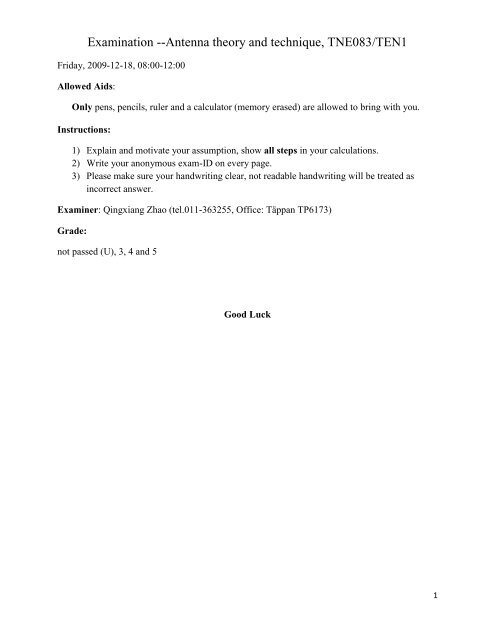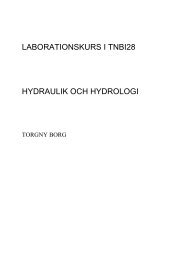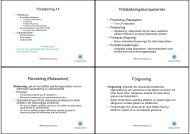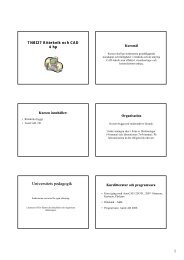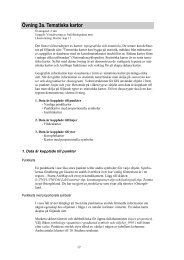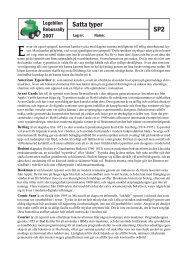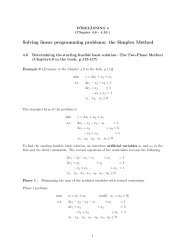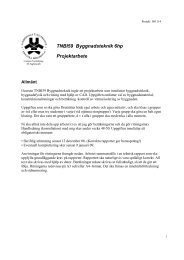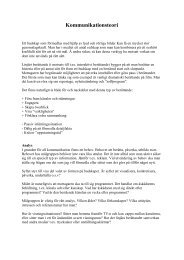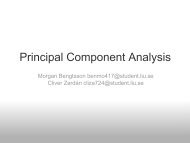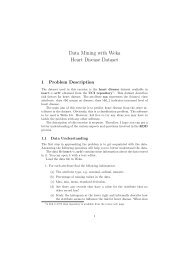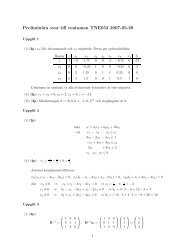Examination --Antenna theory and technique, TNE083/TEN1
Examination --Antenna theory and technique, TNE083/TEN1
Examination --Antenna theory and technique, TNE083/TEN1
Create successful ePaper yourself
Turn your PDF publications into a flip-book with our unique Google optimized e-Paper software.
<strong>Examination</strong> --<strong>Antenna</strong> <strong>theory</strong> <strong>and</strong> <strong>technique</strong>, <strong>TNE083</strong>/<strong>TEN1</strong>Friday, 2009-12-18, 08:00-12:00Allowed Aids:Only pens, pencils, ruler <strong>and</strong> a calculator (memory erased) are allowed to bring with you.Instructions:1) Explain <strong>and</strong> motivate your assumption, show all steps in your calculations.2) Write your anonymous exam-ID on every page.3) Please make sure your h<strong>and</strong>writing clear, not readable h<strong>and</strong>writing will be treated asincorrect answer.Examiner: Qingxiang Zhao (tel.011-363255, Office: Täppan TP6173)Grade:not passed (U), 3, 4 <strong>and</strong> 5Good Luck1
1.Choose the correct answer in each of following questions,(I) An antenna is a device that, in the transmitting mode, converts _______ waves to___________ waves. ((A) traveling, guided,(B) free-space, traveling, (C) guided, free-space).(II) A radiator having equal radiation in all directions is referred to as a _______.((A)directional radiator, (B) isotropic radiator,(C) guided radiator).(III) A portion of the radiation pattern bounded by regions of relatively weak radiation isreferred to as radiation_________. ((A) efficiency, (B) lobe, (C) impedance).(IV) For two isotropic sources, both fed with the same amplitude <strong>and</strong> phase, what is theminimum spacing between elements required in order to form at least one null in the arrayfactor? ((A) lambda/4, (B) lambda/2, (C) lambda).(V) A radiator having the property of radiating or receiving electromagnetic waves moreeffectively in some directions than in others is referred to as a _______.((A) directionalantenna, (B) isotropic antenna, (C) ominidirectional antenna).2. An array of isotropic sources consists of five elements, spaced according to the Figure belowwith equal spacing d between the elements. The elements have excitations (differentamplitudes) with the same phase as shown in the Figure.a) Find the array factor.b) Find the smallest spacing d such that a null is formed in the = 0 ◦ plane at an angle of = 45 ◦from the z axis.3. A dipole antenna has the following parameters, length is 0.5 λ, excitation current is 2 A <strong>and</strong>operating frequency is 1 GHz. The radiation produced by the antenna is observed by a suitableequipped receiver at a distance of 200 m. For this arrangement, calculate (a) the antennaradiation resistance, (b) the electric field <strong>and</strong> magnetic field strength at the observation point,(c) the gain of the dipole relative to isotropic source.2
4. Consider two conter-fed half-wavelength dipole antenna arranged to form a two element endfirearray. The element separation is one-quarter wavelength, <strong>and</strong> the elements are supplied withequal power signals but different excitation current <strong>and</strong> different phase as indicated in thefollowing figure. For this arrangement, we wish to find the ratio of the currents at the inputterminals of the antenna, the gain of the array relative to a single conter-fed halfwavelengthdipole antenna, <strong>and</strong> derive the normalized array factor. Assume that the mutualimpedance between dipole is 40 –j30 .5. Design a constant current circular loop so that its far-field pattern has a null in the plane of theloop, <strong>and</strong> three nulls above <strong>and</strong> three nulls below the plane of the loop.a) Find the radius of the loop.b) Find the angles where the nulls occur.Hint: The far-field components radiated by a circular loop of radius a <strong>and</strong> constant current I 0are given bywhere J 1 (z) is the Bessel function of the first order. For the Bessel function [J 1 (z n ) = 0]occur at z 1 =0, z 2 =3.83, z 3 =7.02, z 4 =10.17, . . .6. Two antennas are separated by a distance R. Derive the equation which relates the powerreceived to the power transmitted between these two antennas (in the so called free-space pathequation or Friis transmission equation form).7. Please indicate your bonus from your home work assignments.i.e. Bonus=3


